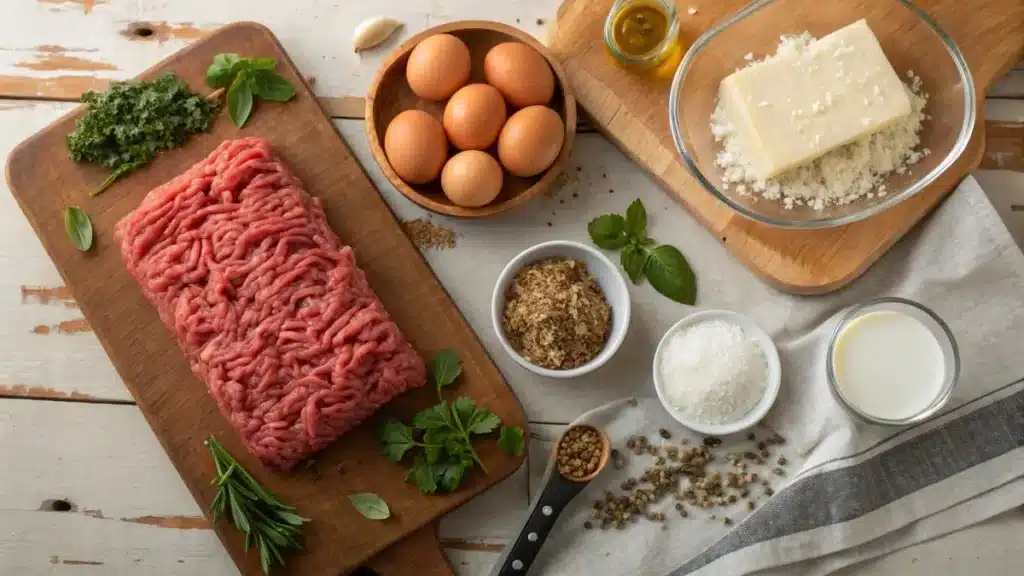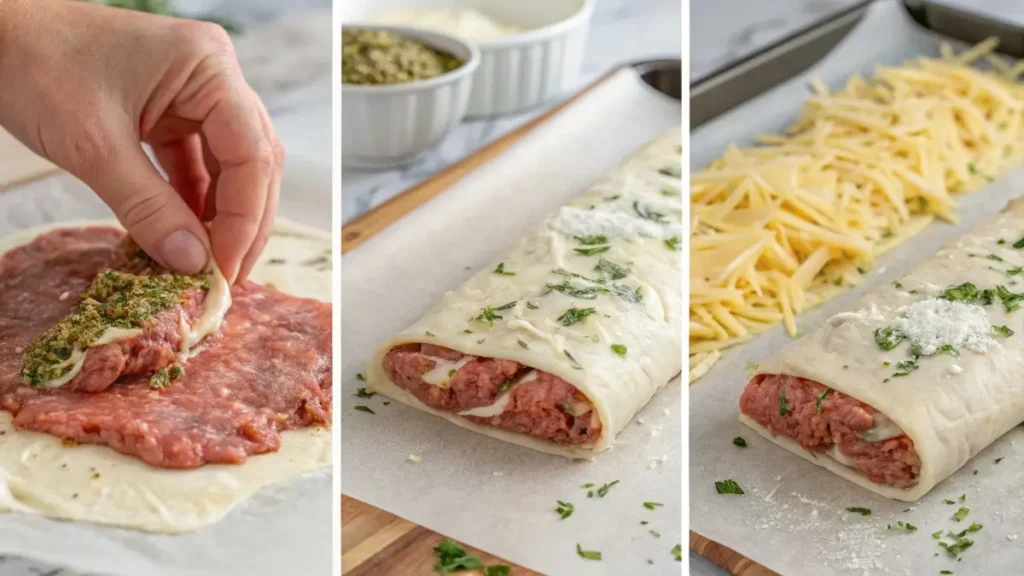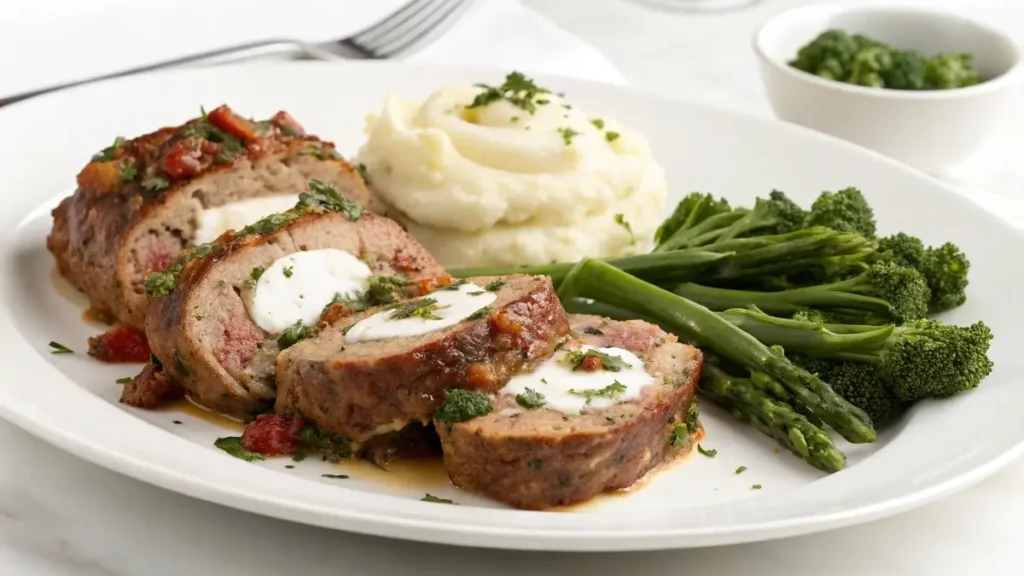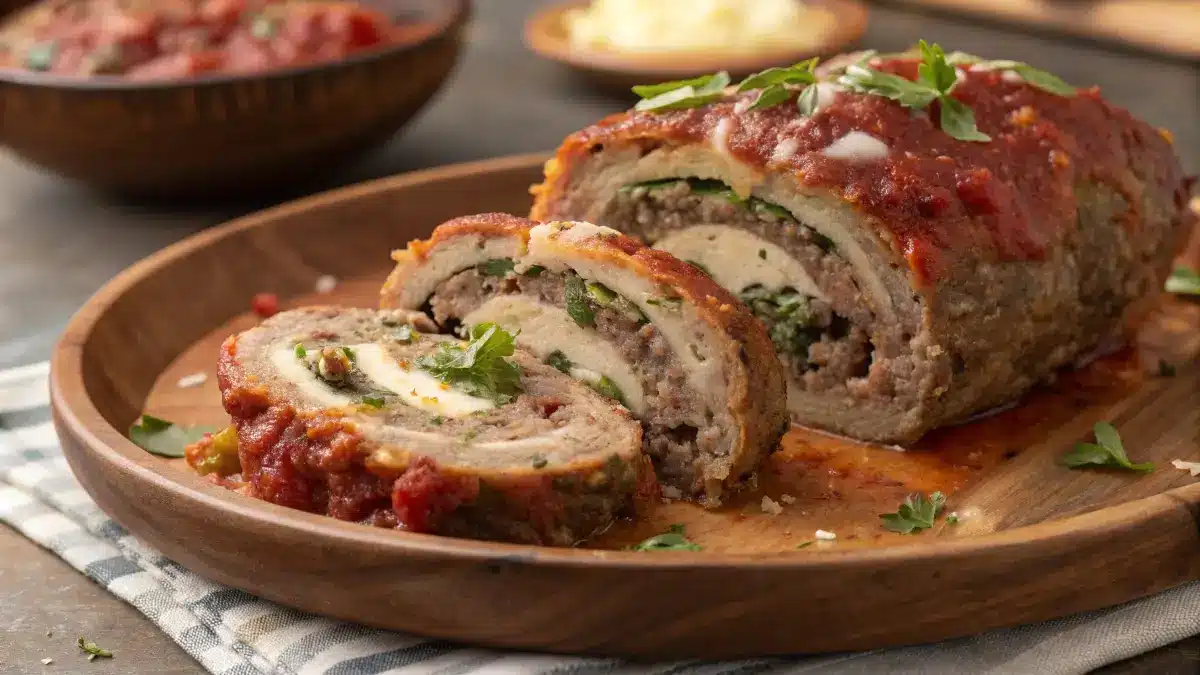Meatloaf Braciole Recipe – The Ultimate Italian-American Comfort Fusion
Looking to wow your dinner guests with something hearty, cheesy, and full of flavor? This meatloaf braciole recipe brings together the best of two worlds—classic Italian braciole and good ol’ American meatloaf. Imagine tender ground meat rolled around savory fillings like provolone, garlic, and fresh herbs, then baked to perfection in a rich tomato sauce. It’s rustic. It’s juicy. And it’s easier than you think.
In this complete guide, we’ll walk you through everything you need to know—from ingredients and cooking methods to common mistakes and expert tips. Whether you’re new to Italian cooking or a seasoned home chef, this recipe delivers big flavor without fuss.
Check out this bold twist on meatloaf if you love creative spins on comfort food.
Table of Contents
What is Meatloaf Braciole and Why Everyone’s Talking About It
Understanding the Origin of Braciole and Meatloaf Fusion
Braciole, pronounced brah-zho-lay, is a traditional Italian dish that typically involves thinly sliced beef rolled around a flavorful stuffing—usually garlic, cheese, and herbs. These bundles are then slow-cooked in tomato sauce until tender. On the other hand, meatloaf is the classic American family staple made from ground meat and baked into a loaf shape.
The meatloaf braciole recipe combines these two traditions in the most delicious way: ground beef or pork is flattened into a rectangle, layered with a savory filling, rolled like braciole, then baked like meatloaf. It’s a mash-up that honors Italian roots while fitting neatly into weeknight dinner territory.
By combining the rolling technique of braciole with the juicy texture of meatloaf, you get the best of both worlds—maximum flavor, no slicing beef required.
How Meatloaf Braciole Differs from Traditional Recipes
Unlike traditional meatloaf, which is packed into a pan, this version is rolled, giving you beautiful swirls of melted cheese and seasoned filling in every slice. That rolling technique doesn’t just elevate presentation—it intensifies flavor by layering herbs, spices, and textures.
Here’s what makes meatloaf braciole unique:
| Feature | Traditional Meatloaf | Meatloaf Braciole |
|---|---|---|
| Shape | Loaf | Rolled |
| Filling | Mixed in | Rolled inside |
| Cooking | Often topped with ketchup | Baked in marinara |
| Texture | Dense | Layered and juicy |
It’s also more flexible than traditional braciole, which usually requires pounding and rolling tougher cuts of meat. With ground meat, you skip the heavy prep but keep all the flavor.
Why This Recipe is Gaining Popularity in Italian-American Kitchens
So, what’s driving the popularity of this dish in home kitchens across the U.S.?
- Ease of preparation: No need for pounding meat or slow-cooking on the stovetop.
- Freezer-friendly: Make-ahead options make this a winner for busy households.
- Comfort food vibes: It’s hearty, saucy, cheesy, and super satisfying.
- Kid-friendly: Unlike braciole, this version is softer and easier to chew, making it a family hit.
Social media food creators and TikTok chefs have also helped bring meatloaf braciole into the limelight by sharing stunning cross-section cuts of the roll, dripping with melted cheese and marinara sauce.
Discover great ideas like this flavorful fusion in our Tuscan Chicken Meatballs with Gnocchi.
Ingredients You Need for the Perfect Meatloaf Braciole
Classic Italian Ingredients and Pantry Staples
To create the ultimate meatloaf braciole recipe, you’ll need a balance of Italian flavors and key pantry staples. Below is a comprehensive list of the must-have ingredients to get that savory, tender texture with bold Mediterranean flair.

Base Meat Mix
- 1 lb ground beef (80/20 for moisture)
- ½ lb ground pork or veal (optional for richer flavor)
Binders & Moisture Agents
- 2 large eggs
- ½ cup milk (preferably whole milk)
- ¾ cup Italian breadcrumbs
Aromatics & Herbs
- 1 small yellow onion, finely chopped
- 2 cloves garlic, minced
- 1 tbsp fresh parsley
- 1 tsp dried oregano
- 1 tsp dried basil
- Salt & cracked black pepper to taste
Cheese Filling (Rolled Inside)
- 1 cup shredded provolone or mozzarella
- ¼ cup grated Parmesan or Pecorino Romano
Sauce Topping
- 2 cups marinara sauce (homemade or store-bought)
- 2 tbsp tomato paste for richness
- 1 tsp red pepper flakes (optional for heat)
Olive Oil (for sautéing onions and garlic)
- 1–2 tbsp extra virgin olive oil
Pro Tip:
Let your meat mixture rest for 10 minutes before shaping—it allows the breadcrumbs and milk to fully hydrate, which prevents dry, crumbly meatloaf.
Optional Add-ins: Cheeses, Herbs, and Binders
Want to get fancy? Here are optional extras that can make your meatloaf braciole even more irresistible.
| Add-In | Benefit |
|---|---|
| Fontina or Asiago Cheese | Adds creamy meltiness |
| Roasted Red Peppers | Brings sweetness and color |
| Sun-Dried Tomatoes | Boosts umami |
| Spinach (blanched & chopped) | Adds nutrients and color |
| Toasted pine nuts | Adds texture and a nutty twist |
When using stronger cheeses like gorgonzola or aged provolone, use sparingly—they can overpower the dish. Keep your flavor balance in check by pairing intense fillings with a mild marinara sauce.
Looking for inspiration? Try these ground beef slow cooker ideas to explore more meat-based comfort meals.
Why Milk Instead of Water in Meatloaf: Moisture Secrets Explained
Many home cooks wonder: why use milk in meatloaf instead of water?
Here’s the secret—milk doesn’t just add moisture; it activates the starch in breadcrumbs or oats, creating a light, juicy texture. Water lacks the fats and natural sugars that milk has, so it doesn’t offer the same tenderizing effects.
Let’s break it down:
| Liquid | Effect on Texture | Flavor Impact |
|---|---|---|
| Milk | Moist, tender | Creamy and rich |
| Water | Can be dry | Neutral or bland |
| Broth | Flavorful | Salty or savory depending on type |
And if you’re lactose-intolerant? Go for unsweetened almond milk or oat milk. They work great without compromising the softness.
Learn more about Italian-style fillings with this twist on Chicken Ricotta Meatballs, a fantastic inspiration for your braciole stuffing.
How to Make Meatloaf Braciole – Step-by-Step Cooking Instructions
Preparing the Ground Meat and Filling
Before shaping your meatloaf braciole, it’s critical to prepare a well-balanced, flavorful meat mixture. The right texture starts with the right process.
Step 1: Sauté Aromatics for Extra Flavor
- Heat 1 tablespoon olive oil in a skillet over medium heat.
- Add finely diced onions and sauté for 2–3 minutes.
- Toss in the minced garlic and cook for another 30 seconds until fragrant.
- Let this mixture cool slightly before combining with the meat.
Step 2: Mix the Meat Base
In a large bowl, gently combine:
- Ground beef (and pork, if using)
- Cooked onion and garlic
- Breadcrumbs
- Eggs
- Milk
- Herbs and seasonings (salt, pepper, oregano, basil, parsley)
Important Tip: Don’t overmix! Overworking the meat will create a dense, tough texture. Use your hands to gently combine until just incorporated.
Step 3: Prepare the Cheese Filling
Mix shredded provolone and grated parmesan with a bit of chopped parsley. You can also add chopped spinach, roasted peppers, or cooked mushrooms if desired.
Rolling and Securing Braciole: Traditional vs. Loaf Style
Once your meat mixture and filling are ready, it’s time to shape the roll.

How to Shape Your Braciole Meatloaf:
- Lay a sheet of parchment paper or plastic wrap on your counter.
- Flatten the meat mixture into a rectangle, about ¾-inch thick and 10×12 inches in size.
- Spread the cheese mixture evenly over the top, leaving a 1-inch border.
- Roll it up tightly like a jelly roll, starting from the short side.
- Pinch the seams closed and tuck the ends under to seal.
This rolled structure mimics traditional braciole but with the ease of ground meat. Want a firmer roll? Chill it in the fridge for 15 minutes before baking.
Bonus Tip:
You can also wrap the roll in bacon or pancetta strips before baking for extra flavor and presentation.
Baking or Simmering: Choosing the Right Cooking Method
You’ve got two main options for cooking your meatloaf braciole, and both are delicious.
Option 1: Baking (Most Common Method)
- Preheat your oven to 375°F (190°C).
- Place the roll seam-side down in a greased baking dish.
- Pour half the marinara sauce over the top.
- Cover with foil and bake for 30 minutes.
- Remove foil, add more sauce, and bake uncovered for another 20–25 minutes until internal temp reaches 160°F (71°C).
- Let it rest 10 minutes before slicing.
Option 2: Simmering in Sauce (Traditional Braciole Style)
- Brown the roll in a skillet to get a crust.
- Transfer to a Dutch oven or deep pot.
- Pour in 3–4 cups marinara sauce to cover.
- Simmer on low for 45–60 minutes with the lid slightly ajar.
This method gives a softer, saucier result—perfect for serving over pasta or polenta.
Check out this rich twist on Italian comfort food for more oven-baked inspiration.
Meat Choices and Substitutes for Every Diet
Can You Make Braciole with Ground Beef? Full Breakdown
Absolutely. Traditional braciole typically uses thin slices of flank or round steak, but ground beef transforms this dish into something both easier and just as flavorful. Using ground beef in a meatloaf braciole recipe eliminates the need for pounding meat and simplifies the rolling process.
When choosing ground beef:
- Use 80/20 or 85/15 lean-to-fat ratio for juicy results.
- Avoid extra-lean beef, as it can lead to a dry, crumbly texture.
- Grass-fed beef gives a deeper flavor, though conventional works just fine.
Why ground beef works so well:
- It binds easily with breadcrumbs, eggs, and milk.
- The texture is tender and perfect for rolling.
- It absorbs seasonings more effectively than sliced beef.
Don’t miss our slow cooker beef dish ideas for more comfort food made easy.
Using Pork, Veal, or Plant-Based Meats in Braciole
While ground beef is the go-to, you can customize your meatloaf braciole with other proteins for different flavor profiles and dietary needs.
| Meat Type | Flavor Profile | Recommended Ratio |
|---|---|---|
| Ground Pork | Rich and juicy | 50% pork / 50% beef |
| Ground Veal | Tender, mild | 30% veal / 70% beef |
| Ground Turkey | Lean, subtle | 100% or blend with pork for moisture |
| Plant-Based (Beyond/Impossible) | Savory, vegan-friendly | Use with vegan binder and no egg or cheese |
Pro Tips:
- If using lean meats like turkey or chicken, double-check for moisture. Add extra egg and a splash of milk.
- For plant-based versions, add flax egg or aquafaba as a binder.
Looking for inspiration? Try our Tuscan Chicken Meatballs with Gnocchi to explore meat variations in Italian-style dishes.
Tips for Making It Gluten-Free or Low-Carb
If you’re watching carbs or avoiding gluten, here’s how to adjust your meatloaf braciole without sacrificing taste:
Gluten-Free Options
- Use certified gluten-free breadcrumbs or crushed rice crackers.
- Sub oats or quinoa flakes for a hearty binder.
- Check your marinara label for hidden gluten.
Low-Carb & Keto-Friendly Adjustments
- Replace breadcrumbs with almond flour or crushed pork rinds.
- Use full-fat cheese and avoid starchy fillers.
- Serve with zucchini noodles or roasted vegetables instead of pasta.
Learn more about adaptable Italian recipes with this flavorful twist on Chicken Ricotta Meatballs, perfect for low-carb plans.
Comparing Italian Meatloaf and American Meatloaf
Texture, Fillings, and Binding Differences
At first glance, both Italian and American meatloaf may look similar—they’re baked, meaty, and served in slices. But dig a little deeper and you’ll find major differences in ingredients, technique, and even intent.
Italian-style meatloaf, like our meatloaf braciole recipe, leans into layered fillings, herbs, and sometimes rolling or stuffing. American versions tend to be simpler, with all ingredients mixed into a homogeneous loaf.
| Feature | Italian Meatloaf (Polpettone) | American Meatloaf |
|---|---|---|
| Texture | Layered, rolled, tender | Dense, cohesive, sometimes dry |
| Fillings | Stuffed with cheese, herbs, eggs | Mixed throughout |
| Sauce | Simmered in marinara or gravy | Topped with ketchup or BBQ |
| Seasoning | Basil, oregano, garlic | Onion, Worcestershire, mustard |
| Shape | Sometimes rolled, loaf-shaped | Always loaf-shaped |
Italian meatloaf tends to be lighter and more flavorful, thanks to fresh herbs, cheese, and olive oil. The American version is hearty and rustic, designed to stretch meat and feed a family on a budget.
Regional Flavor Profiles and Seasoning Techniques
Italian braciole-based meatloaf reflects Mediterranean flavors:
- Parmesan or Pecorino for saltiness
- Provolone or mozzarella for creaminess
- Fresh basil, parsley, and oregano for herbal notes
- Olive oil instead of butter
In contrast, the American version might include:
- Yellow mustard or ketchup in the mix
- Diced celery or bell pepper
- A brown sugar glaze
- Less seasoning, more bulk
Both are delicious—but the Italian method feels more elegant and celebratory, while the American classic is perfect for casual comfort food.
What is in Paula Deen’s Meatloaf Compared to Italian Versions?
Paula Deen’s meatloaf is a beloved example of the Southern U.S. take on meatloaf. Here’s what typically goes into it:
- Ground beef (or a beef-pork blend)
- Eggs and crushed crackers (instead of breadcrumbs)
- Ketchup and Worcestershire sauce
- Brown sugar glaze or BBQ sauce on top
- Minimal herbs (parsley at most)
Compared to our meatloaf braciole recipe, Paula’s version is:
- Sweeter and tangier
- Less herb-forward
- Topped with a sugary crust
- Not layered or rolled
While both are baked and comforting, the Italian braciole style focuses on savory depth, while Southern-style meatloaf goes big on bold, sticky flavor.
Discover great ideas like this in our Smoky Jalapeño Popper Meatloaf, which blends American comfort with spicy flair.
The Role of Eggs, Milk, and Binders in Meatloaf Braciole
What Does Adding an Extra Egg to Meatloaf Do?
Eggs are more than just a protein boost—they’re the glue that holds your meatloaf together. But what happens when you add one too many?
Here’s the breakdown:
| Number of Eggs | Texture | Binding Power | Moisture |
|---|---|---|---|
| 1 egg (per pound of meat) | Balanced | Good | Moderate |
| 2 eggs (per pound) | Softer | Great | High |
| 3+ eggs | Spongy | Too wet | Overly moist/slippery |
In a meatloaf braciole recipe, 2 eggs per 1.5 pounds of meat is usually ideal. They create a soft texture without turning the loaf rubbery. Too many eggs can lead to a curdled, almost quiche-like structure—not what we’re going for here.
Stick with:
- 1 egg per pound for denser loaves
- 2 eggs per 1.5 lbs for a more tender braciole-style roll
And remember—always beat the eggs before mixing for even distribution.
Breadcrumbs vs. Oats: Which Holds Better?
When it comes to binders, most home cooks default to breadcrumbs. But oats are rising in popularity for their heartiness and gluten-free potential. So which should you use?
Breadcrumbs (Classic Choice)
- Absorb milk well
- Create a soft, uniform texture
- Traditional in both Italian and American meatloaf
Rolled Oats (Alternative Choice)
- Slightly chewy texture
- Ideal for gluten-free or rustic recipes
- Less smooth but more “whole food” feel
Quick Tip: Avoid panko or coarse bread crumbs in braciole-style meatloaf—they can make the roll fall apart during baking.
Want to experiment? Try a 50/50 mix of oats and breadcrumbs for a more structured, fiber-rich loaf.
Common Mistakes and What Not to Put in Meatloaf
There’s a fine line between a moist, flavorful meatloaf and a soggy, greasy mess. Avoid these common errors:
Skipping the binder
Without breadcrumbs, oats, or crackers, your loaf will crumble.
Overloading with vegetables
Raw bell peppers or tomatoes add too much moisture. Always sauté veggies first.
Using only lean meat
Ground turkey or lean beef (90/10) needs extra fat or moisture to avoid a dry loaf.
Overmixing the meat
This makes the loaf tough. Mix just until combined.
Skipping seasoning
Underseasoning is a common braciole mistake. Be generous with herbs, salt, and garlic.
Not letting it rest
Always let your meatloaf braciole sit for 10–15 minutes before slicing. It firms up and becomes easier to cut.
Learn more about balancing meat, moisture, and texture from this Chicken Ricotta Meatballs with Spinach Alfredo Sauce recipe, which nails structure and flavor.
Topping, Sauces, and Serving Ideas
Classic Marinara vs. Rich Tomato Sauce for Braciole
One of the biggest flavor enhancers in any meatloaf braciole recipe is the sauce. And while both marinara and tomato-based sauces work, the difference lies in the depth and complexity of flavor.
Classic Marinara
- Light, quick-cooked
- Often includes garlic, olive oil, crushed tomatoes, and basil
- Best for a fresh, herby finish
Rich Tomato Sauce
- Slow-simmered for deeper flavor
- May include onions, wine, tomato paste, and a touch of sugar
- More intense, thicker, and ideal for baking
For this recipe, a hybrid sauce works best—start with marinara and enhance it with tomato paste and a pinch of chili flakes. It clings better to the meat and provides that savory depth Italian comfort food is known for.
Tip: Spoon half the sauce over the meatloaf before baking and reserve the rest for serving.
Looking for inspiration? Try the Smoky Jalapeño Popper Meatloaf for an alternative approach to saucing.

Cheesy Toppings, Crusts, and Italian Garnishes
When it comes to finishing touches, don’t stop at sauce. The right topping brings both flavor and visual appeal.
Best Cheese Toppings
- Mozzarella: Melts beautifully and adds a gooey layer
- Parmesan: Creates a sharp, salty crust
- Provolone: Creamy and mild with excellent melt
Layer cheese over the top in the final 10 minutes of baking to avoid burning. If you’re broiling, monitor closely to prevent blistering.
Herbal Finishes
- Chopped basil or flat-leaf parsley
- A drizzle of olive oil infused with garlic
- Toasted pine nuts for added texture (optional)
Best Side Dishes to Pair With Meatloaf Braciole
A dish this flavorful deserves complementary sides. Here’s a list of Italian and American-style accompaniments that balance out the rich, savory profile of the meatloaf braciole.
| Side Dish | Flavor Pairing | Why It Works |
|---|---|---|
| Garlic mashed potatoes | Creamy, neutral | Balances acidity of tomato sauce |
| Roasted broccolini | Bitter, earthy | Adds green freshness |
| Polenta | Buttery, smooth | Traditional Italian pairing |
| Caesar salad | Tangy, crunchy | Lightens the plate |
| Pasta with olive oil and herbs | Mild, aromatic | Keeps focus on the meat |
Want to keep it low-carb? Swap pasta for roasted cauliflower or sautéed zucchini ribbons.
Don’t miss our Tuscan Chicken Meatballs with Gnocchi for more ideas on pairing Italian meat-based mains with perfect sides.
Storage, Leftovers, and Make-Ahead Tips
How to Store and Reheat Without Losing Flavor
Whether you’re meal prepping or saving extra slices for later, storing meatloaf braciole properly keeps it moist and flavorful.
Refrigeration Tips:
- Allow the meatloaf to cool to room temperature first.
- Wrap tightly in foil or plastic wrap, or store in an airtight container.
- Store in the fridge for up to 4 days.
Reheating Options:
- Oven (recommended): Place in a baking dish, cover with foil, and reheat at 325°F (163°C) for 20–25 minutes. Add extra marinara if needed to prevent drying out.
- Microwave: Heat slices in 30-second bursts with a splash of sauce on top. Use medium power to avoid overcooking.
- Stovetop (for sauce-rich versions): Simmer gently in a pan with some extra sauce.
Tip: Never reheat uncovered in the oven—it’ll dry out the top layer. Use foil to trap steam and moisture.
Freezing Meatloaf Braciole for Meal Prep
This dish freezes beautifully. Whether you freeze the whole roll or individual slices, it’s a great meal-prep solution.
To Freeze Uncooked Meatloaf Braciole:
- Assemble and roll it as directed.
- Wrap tightly in plastic wrap, then foil.
- Label and freeze for up to 3 months.
- Thaw in the fridge overnight before baking as usual.
To Freeze Cooked Meatloaf Braciole:
- Let it cool completely.
- Slice for easier reheating.
- Wrap each slice in foil or store in a freezer-safe container.
- Best used within 2–3 months for peak flavor.
Transforming Leftovers Into Delicious Second-Day Meals
Leftover meatloaf doesn’t have to be boring. Here are some creative ideas to breathe new life into your braciole slices:
| Leftover Idea | Description |
|---|---|
| Braciole Sandwich | Layer a slice with melted provolone and extra sauce on a toasted ciabatta roll. |
| Braciole Pasta Bake | Cube leftover slices, toss with penne and marinara, top with mozzarella, and bake. |
| Italian Breakfast Hash | Chop and fry with diced potatoes, onions, and eggs. |
| Stuffed Bell Peppers | Mix chopped braciole with rice and stuff into halved bell peppers. Bake with cheese. |
| Meatloaf Lasagna | Use sliced meatloaf in place of one meat layer for a bold lasagna twist. |
Learn more about repurposing rich meat recipes in our collection of ground beef crock pot dishes, perfect for meal planning.
Expert Cooking Tips and Troubleshooting
Why Your Meatloaf Might Be Falling Apart – Fixes & Solutions
One of the most common frustrations with any meatloaf—especially a rolled one like braciole—is that it falls apart when sliced. Here’s how to avoid that disaster.
Common Mistakes That Cause Crumbling:
- Not enough binder: You need enough breadcrumbs or oats and eggs to hold everything together.
- Too lean meat: A little fat keeps the structure moist and intact. Aim for 80/20 ground beef.
- Overmixing: Mixing the meat too much breaks down the proteins, leading to a mushy or crumbly texture.
- No resting time: Always let your meatloaf braciole rest at least 10–15 minutes before slicing.
Fix it next time:
- Use 1 cup breadcrumbs and 2 eggs per 1.5 pounds of meat.
- Let the loaf cool and settle before slicing—warm meatloaf is delicate.
Overbaked or Undercooked? Time and Temp Guidelines
Baking too long dries out the roll; underbaking leads to a raw center. Here’s how to get it just right.
Best Practices:
- Use a meat thermometer. Internal temperature should reach 160°F (71°C).
- Bake at 375°F (190°C), covered for the first 30 minutes, then uncovered for browning.
- If the outside browns too fast, tent loosely with foil.
Cooking Time Guidelines:
| Weight | Cooking Time |
|---|---|
| 1.5 lbs | 45–55 minutes |
| 2 lbs | 55–65 minutes |
| 3 lbs | 70–85 minutes |
Pro Tip: If your braciole is rolled tightly and thick, increase the baking time slightly or reduce oven temp to 350°F to cook more evenly.
How to Get That Perfect Roll Every Time
The signature swirl of a meatloaf braciole is what sets it apart—but rolling it improperly can lead to gaps, broken seams, or uneven layers.
Pro Rolling Tips:
- Flatten the meat mixture evenly—too thin and it tears, too thick and it won’t roll well.
- Leave a 1-inch border to prevent filling from spilling out.
- Use parchment paper or plastic wrap to roll tightly and evenly.
- Chill the roll for 15 minutes before baking to firm it up.
Want even cleaner slices? Use a serrated knife and wipe it clean between each cut.
Check out other successful meat-and-cheese combinations like our Chicken Ricotta Meatballs with Spinach Alfredo for inspiration on layering and stuffing.
Conclusion: Bring Old-World Flavor to Your Kitchen with This Meatloaf Braciole Recipe
Combining the savory richness of Italian braciole with the homey comfort of American meatloaf, this meatloaf braciole recipe delivers bold flavor in every tender, cheesy slice. Whether you’re hosting a Sunday family dinner or prepping freezer-friendly meals for the week, this dish brings together ease, tradition, and serious satisfaction.
From choosing the best ground meat to layering Italian cheeses and simmering in tomato sauce, every step is designed to elevate a humble loaf into something memorable. Want to personalize it? Try swapping in turkey, veal, or plant-based meat and add your favorite herbs or veggies.
Don’t miss our Smoky Jalapeño Popper Meatloaf if you want another creative spin on classic comfort dishes.
FAQs
Can you make braciole with ground beef?
Yes, and it’s one of the best shortcuts for home cooks. Ground beef simplifies the traditional rolled meat technique used in braciole, making it easier to shape and bake. It also absorbs flavors better than sliced cuts, producing a juicy and savory interior when properly seasoned and rolled.
What is in Paula Deen’s meatloaf?
Paula Deen’s Southern-style meatloaf typically features ground beef, eggs, chopped onions, milk, crushed Ritz crackers, and a ketchup-based glaze. It differs from meatloaf braciole by focusing on simple mixing rather than layering or rolling. There’s no cheese filling or marinara sauce like in the Italian version.
What is the difference between Italian meatloaf and American meatloaf?
Italian meatloaf, or polpettone, often includes cheeses, herbs, and rolled fillings. It’s usually served with marinara sauce and may be rolled like braciole. American meatloaf is denser, topped with ketchup or BBQ sauce, and uses different seasonings such as Worcestershire and mustard. The presentation and flavor profiles differ significantly.
What does adding an extra egg to meatloaf do?
An extra egg adds moisture and improves binding. However, too many eggs can create a rubbery or overly soft texture. For best results, use 1 egg per pound of meat, or 2 for 1.5 pounds in rolled versions like meatloaf braciole.
Why milk instead of water in meatloaf?
Milk adds richness, activates the starches in breadcrumbs, and creates a tender texture. Water lacks the fats and proteins needed to achieve the same effect. Milk-soaked binders are key to preventing dry meatloaf.
What not to put in meatloaf?
Avoid these common pitfalls:
Raw vegetables (unless pre-cooked)
Overly lean meats
Excess eggs or liquids
Skipping binders (breadcrumbs or oats)
These errors lead to soggy, dry, or crumbly results that lack structure and flavor.

